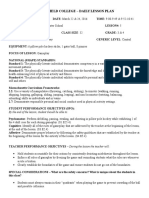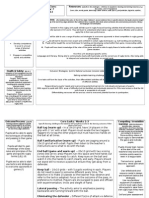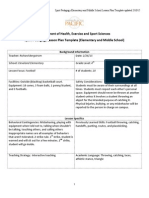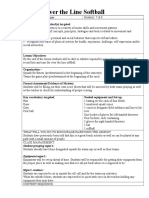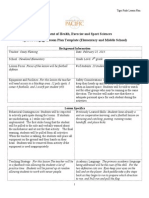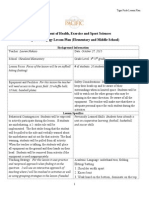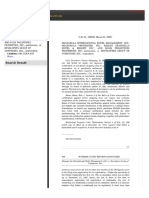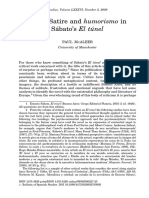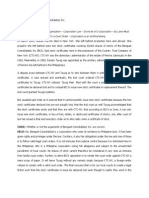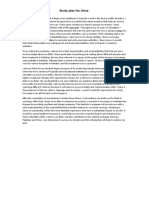Lessonplanbadminton
Lessonplanbadminton
Uploaded by
api-250641049Copyright:
Available Formats
Lessonplanbadminton
Lessonplanbadminton
Uploaded by
api-250641049Original Title
Copyright
Available Formats
Share this document
Did you find this document useful?
Is this content inappropriate?
Copyright:
Available Formats
Lessonplanbadminton
Lessonplanbadminton
Uploaded by
api-250641049Copyright:
Available Formats
Texas A&M UniversityCommerce
Teacher: Everett Wilder Mentor: Jeremy Scroggins
that is varying distance away from each server.
Daily Lesson Plan Form
Subject: PE Sulphur Springs Grade Level: 10-11 Date:
Overall Goal of Lesson: To have students work on their badminton serves by hitting the shuttlecock into a hula hoop Instructional Objectives: Badminton, serving- making contact with the shuttlecock, land the shuttlecock, land the
shuttlecock in the hoop in as few shots as possible. The group with the lowest number of shots will win a reward (group scores will be averaged if groups are uneven) shuttlecock or Birdie, flagged (2) Social development. During physical activity, the student develops positive self-management and social skills needed to work independently and with others. The student is expected to: (A) apply rules, procedures, and etiquette; and (5) Physical activity and health. The student comprehends practices that impact daily performance, physical activity, and health. The student is expected to:(A) investigate positive and negative attitudes towards exercise and physical activities; ELPS: 74.4 (a)(2) In order for ELLs to be successful, they must acquire both social and academic language proficiency in English. Social language proficiency in English consists of the English needed for daily social interactions. Academic language proficiency consists of the English needed to think critically, understand and learn new concepts, process complex academic material, and interact and communicate in English academic settings. Higher Order Questions: What are some of the different ways to direct what direction your shuttlecock will end up at? How hard do you know how to hit the shuttle?
Texas Essential Knowledge & Skills (TEKS) & ELPS: (typed out completely) 116.52.2.A; 116.52 5.A
Key Vocabulary: badminton, serving, holes, tee box,
Student Activities: (Keep in mind the following: Scaffolding, Independent or Cooperative activities, Groupings, Reading,
Writing, Listening, Hands-On/Minds-On, Connections to previous knowledge, etc) Create Teams and practice serving the shuttlecock into the hoops; students must work together to keep scorecard. They must tally their score by averaging out all team members scores.
Modifications/ELL Strategies For the
younger grades balloon badminton might be a good start before this lesson
Anticipatory Activity for Lesson: Making sure that students are
able to make contact with shuttle. Practice the swing of the racket to make contact with the shuttle. 5-10 minutes
Time Allotted
Teacher Input/Lesson Activity:
1. Each group member will tee off their own birdie from the tee box for each hole (marked by a pylon) 2. To tee off, players must hit an underhand badminton serve. Overhand serves will be penalized by one stroke. 3. After each group member has teed off, players will go to their birdie, and try to hit it into the hoop from their new spot. 4. When retrieving the bird from the new spot, players will walk up to the bird, stand with their feet on either side of it, pick it up, and hit it from there. Players who move closer to the hoop will be penalized one stroke. 5. When hitting the bird into the hoop, the bird must stay inside the hoop for it to count. If it bounces out, the player has to hit it from the new spot. 6. Once all players in a group have completed the hole, that group will mark their score in the appropriate box. This is done by writing the number of strokes into the box for that hole. Make sure to mark your score on the next tee so that groups waiting to play can go ahead. When all players have completed a hole, then the group
25 minutes
can move on.
Modeling: Model proper underhand/overhand swing of badminton. Go over safety first.
Guided Practice: I will walk over first hole to show how the game will work. 5-10 minutes Independent Practice: Each player will practice swinging birdies 10 times to each other before starting;
they must complete 80% accuracy before starting the game.
Lesson Closure: When each group has finished, each group will put up all materials in designated places
then turn in scorecards for tallying.
Assessment Methods/Strategies: Create a simple scorecard (6X10 chart). Top-indicates hole number,
and names go down left-hand column. Bottom Row is used to total scores. Teacher can assess how many holes in one a kid received and how accurate everyone serve is. Resources (supplies, equipment, software, etc.): Nine hula hoops acts as the hole for each on nine golf holes. 18 small cones. One-tee box and the other acts as the flag in each hole. Labels (numbered one-nine, and taped to accompanying pylons, one at tee box, and one at hole.
Reflection: It is essential to learn how to be a team player and learn to get better with new skills.
TEKS: 116.7 (K): demonstrate competence in manipulative skills in dynamic situations such as overhand throw, catch, shooting, hand dribble, foot dribble, kick , and striking activities such as hitting a softball; and 116.7 (2-B): identify the importance of various elements of performance for different stages during skill learning such as form, poser, accuracy, and consistency; and 116.7 (5-A): use equipment safely and properly; ELPS: 74.4 English language Proficiency Standards 74.4 (a)(2): In order for Ells to be successful, they must acquire both social and academic language proficiency in English. Social language proficiency in English consists of the English needed for daily social interactions. Academic language proficiency consists of the English needed to think critically, understand and learn new concepts, process complex academic material, and interact and communicate in English in academic settings.
You might also like
- Sepep Basketball UnitDocument18 pagesSepep Basketball Unitapi-336493156100% (1)
- ICT Tools and Citizen Science A Pathway To Promote Science Learning and Education For Sustainable Development in Schools 2022 RoutledgeDocument18 pagesICT Tools and Citizen Science A Pathway To Promote Science Learning and Education For Sustainable Development in Schools 2022 RoutledgepferradaNo ratings yet
- Year 8 Ultimate Frisbee Unit PlanDocument21 pagesYear 8 Ultimate Frisbee Unit Planapi-321376162No ratings yet
- Modelo Examen 1er Año Instituto CambridgeDocument3 pagesModelo Examen 1er Año Instituto CambridgeGuido Tamer33% (6)
- Hpe Forward Planning DocumentDocument5 pagesHpe Forward Planning Documentapi-279625326No ratings yet
- Pickleball Lesson 4Document5 pagesPickleball Lesson 4api-285501937No ratings yet
- Badminton Day 1Document4 pagesBadminton Day 1api-336798725No ratings yet
- Badminton Lesson PlanDocument9 pagesBadminton Lesson Planapi-271086309No ratings yet
- Pillow Polo Hockey LP - ElementaryDocument6 pagesPillow Polo Hockey LP - ElementaryAlex NiemiecNo ratings yet
- Ped 266 Lesson Plan 2Document6 pagesPed 266 Lesson Plan 2api-283742655No ratings yet
- Racquetball and Paddles Lesson PlanDocument7 pagesRacquetball and Paddles Lesson Planapi-282897455No ratings yet
- Volleyball Unit PlanDocument11 pagesVolleyball Unit PlanLyndal Riley100% (1)
- HazopDocument4 pagesHazopbaaziz2015No ratings yet
- The Aquarian Conspiracy, 1981 - Marilyn Ferguson PDFDocument435 pagesThe Aquarian Conspiracy, 1981 - Marilyn Ferguson PDFLucas G100% (5)
- Floor Hockey Lesson PlanDocument10 pagesFloor Hockey Lesson Planapi-250231039No ratings yet
- LN - Basketball Game Play Week 4 Day 8Document5 pagesLN - Basketball Game Play Week 4 Day 8api-295489714No ratings yet
- Rugby Unit of WorkDocument6 pagesRugby Unit of Workapi-282188476No ratings yet
- Unit PlanDocument21 pagesUnit Planapi-497501541No ratings yet
- LN - Basketball Game Play Week 4 Day 2Document5 pagesLN - Basketball Game Play Week 4 Day 2api-272005741No ratings yet
- Hockey Unit of WorkDocument4 pagesHockey Unit of Workapi-282444428No ratings yet
- Unit of Work Template HandballDocument10 pagesUnit of Work Template Handballapi-282010518No ratings yet
- Unit Plan Floor HockeyDocument50 pagesUnit Plan Floor Hockeyapi-608310470No ratings yet
- Pickleball Lesson PlanDocument4 pagesPickleball Lesson Planapi-269367012No ratings yet
- Year 8 Rugby Unit of Work - 2Document5 pagesYear 8 Rugby Unit of Work - 2api-280262435No ratings yet
- LN - Lesson Plan-Football Handoff Week 3 Day 1Document4 pagesLN - Lesson Plan-Football Handoff Week 3 Day 1api-295489714No ratings yet
- Department of Health, Exercise and Sport Sciences Sport Pedagogy Lesson Plan Template (Elementary and Middle School)Document6 pagesDepartment of Health, Exercise and Sport Sciences Sport Pedagogy Lesson Plan Template (Elementary and Middle School)api-272005741No ratings yet
- Reggie LP 2 26 15Document7 pagesReggie LP 2 26 15api-268216628No ratings yet
- Over The Line Softball Lesson PlanDocument3 pagesOver The Line Softball Lesson Planapi-312487875No ratings yet
- Department of Health, Exercise and Sport Sciences Sport Pedagogy Lesson Plan Template (Elementary and Middle School)Document7 pagesDepartment of Health, Exercise and Sport Sciences Sport Pedagogy Lesson Plan Template (Elementary and Middle School)api-272949500No ratings yet
- Hockey LessonDocument7 pagesHockey Lessonapi-249184864No ratings yet
- Unit of Work Template For Football - EgDocument7 pagesUnit of Work Template For Football - Egapi-312738148No ratings yet
- Netball SowDocument5 pagesNetball Sowapi-282267269No ratings yet
- Golf Lesson PlanDocument3 pagesGolf Lesson PlanZachery SandersonNo ratings yet
- Handball Unit PlanDocument10 pagesHandball Unit Planapi-385512679No ratings yet
- Unit Plan Ultimate FrisbeeDocument7 pagesUnit Plan Ultimate Frisbeeapi-273329891No ratings yet
- Reggie LP 3 5 15Document7 pagesReggie LP 3 5 15api-268216628No ratings yet
- Lesson Plan Field HockeyDocument3 pagesLesson Plan Field Hockeyapi-264409126100% (1)
- Rocketball Lesson PlanDocument4 pagesRocketball Lesson Planapi-548837248No ratings yet
- Psychomot or LF: Learning Domain Nat'l Stand. Com. Core When?Document5 pagesPsychomot or LF: Learning Domain Nat'l Stand. Com. Core When?api-244366876No ratings yet
- Assignment 1 Tiered Lesson TemplateDocument12 pagesAssignment 1 Tiered Lesson Templateapi-428716157No ratings yet
- LESSON PLAN Template FOR PE (Practical Session)Document3 pagesLESSON PLAN Template FOR PE (Practical Session)api-312594855No ratings yet
- Randall Lesson Plan 1Document3 pagesRandall Lesson Plan 1api-247763514No ratings yet
- Rugby 1Document5 pagesRugby 1api-307598514No ratings yet
- Softball UnitDocument10 pagesSoftball UnitsgwebsterNo ratings yet
- Team Handball Lesson Plan- techDocument7 pagesTeam Handball Lesson Plan- techilanagreenstein0704No ratings yet
- Grade 5 Badminton Lesson 1Document4 pagesGrade 5 Badminton Lesson 1api-268585214No ratings yet
- Ped 372 Omnikin Lesson Plan 5Document5 pagesPed 372 Omnikin Lesson Plan 5api-283742655No ratings yet
- BadmintonDocument7 pagesBadmintonapi-283239473No ratings yet
- Pe Lesson PlanDocument3 pagesPe Lesson Planapi-283529633No ratings yet
- 5E Lesson Plan Template: TeacherDocument4 pages5E Lesson Plan Template: Teacherapi-526293827No ratings yet
- Day 2Document6 pagesDay 2api-301997928No ratings yet
- Phyed Lesson PlanDocument7 pagesPhyed Lesson Planapi-247283340No ratings yet
- Reggie LP 2 24 15Document9 pagesReggie LP 2 24 15api-268216628No ratings yet
- Football D 2-25-15Document5 pagesFootball D 2-25-15api-254566763No ratings yet
- LN - Softball Hitting LP Week 6 Day 11Document5 pagesLN - Softball Hitting LP Week 6 Day 11api-295489714No ratings yet
- Lesson Plan - VELS Hpe Edfd 1.6Document9 pagesLesson Plan - VELS Hpe Edfd 1.6Kara MyersNo ratings yet
- PEP 421 - Secondary Methods in Physical Activity Pedagogy Lesson PlanDocument18 pagesPEP 421 - Secondary Methods in Physical Activity Pedagogy Lesson Planapi-317993612No ratings yet
- Unit Plan BadmintonDocument4 pagesUnit Plan Badmintonapi-215259691No ratings yet
- 20059555unitofworkbasketballDocument8 pages20059555unitofworkbasketballapi-400201070No ratings yet
- Springfield College - Lesson PlanDocument2 pagesSpringfield College - Lesson Planapi-459682479No ratings yet
- Grade 7 Handball Lesson ThreeDocument2 pagesGrade 7 Handball Lesson Threeapi-312912901No ratings yet
- Skill 2 Lesson PlanDocument3 pagesSkill 2 Lesson Planapi-272005741No ratings yet
- Overhand Throwing 2Document9 pagesOverhand Throwing 2api-704401848No ratings yet
- Contingency Approach Block BDocument20 pagesContingency Approach Block BJonafe JuntillaNo ratings yet
- Swot Analysis Seamen's HospitalDocument17 pagesSwot Analysis Seamen's HospitalCris Cancio67% (3)
- SMK Mekanik Cibinong: Ulangan Harian " Offering and Suggestion Nama: Kelas: TanggalDocument5 pagesSMK Mekanik Cibinong: Ulangan Harian " Offering and Suggestion Nama: Kelas: TanggalMELANI NURROCHMAHNo ratings yet
- Research Report: The Leisure Time Activities of International University Students Are Different From The Activities They Did As School StudentDocument18 pagesResearch Report: The Leisure Time Activities of International University Students Are Different From The Activities They Did As School StudentgrayNo ratings yet
- Lesson Plan GP IgcseDocument13 pagesLesson Plan GP IgcseMuhammad Azhar AnnasNo ratings yet
- CSE Dept. PPT 176 173Document17 pagesCSE Dept. PPT 176 173sushanthreddy00007No ratings yet
- Remploy Accord 2010Document202 pagesRemploy Accord 2010gemini4867% (3)
- Pen Testing Active Directory EnvironmentsDocument29 pagesPen Testing Active Directory Environmentscipdale100% (2)
- Sequencing of EventsDocument19 pagesSequencing of EventsGleen PayotNo ratings yet
- Hazard Risk Assessment Study-VopakDocument93 pagesHazard Risk Assessment Study-VopakSankar Cdm100% (1)
- Gear LecturDocument50 pagesGear LecturMuralikrishnan GM100% (1)
- GearsDocument8 pagesGearsKevin JoeNo ratings yet
- Social StudiesDocument17 pagesSocial Studiesjade tagabNo ratings yet
- Transverse Urea-Gradient Gel Electrophoresis UNIT 7.4 BASIC PROTOCOLDocument13 pagesTransverse Urea-Gradient Gel Electrophoresis UNIT 7.4 BASIC PROTOCOLNancy Marianna Muñoz ValeraNo ratings yet
- LESSON 21 - at The HospitalDocument3 pagesLESSON 21 - at The HospitalThanh VyNo ratings yet
- Electromagnetism - DPP 01 - Abhimanyu 2.0 (Telugu)Document3 pagesElectromagnetism - DPP 01 - Abhimanyu 2.0 (Telugu)pragnakrishnan5No ratings yet
- ObservationDocument15 pagesObservationpdhuri067No ratings yet
- Greenwich in The Mean TimeDocument41 pagesGreenwich in The Mean TimePsy0psAgent100% (3)
- Shangri-La vs. Developers Group of CompanyDocument18 pagesShangri-La vs. Developers Group of CompanyKrister Vallente100% (1)
- Irony, Satire and Humorismo in Sabato's El TunelDocument26 pagesIrony, Satire and Humorismo in Sabato's El TunelSandra ManuelsdóttirNo ratings yet
- DETAILED INDEX of The Freeman Kitchens Collection, WKUDocument12 pagesDETAILED INDEX of The Freeman Kitchens Collection, WKUmissjamesonNo ratings yet
- Corporation Law Case DigestDocument97 pagesCorporation Law Case DigestZypress AcacioNo ratings yet
- Consolidation: GLE/CEE 330 Lecture Notes Soil MechanicsDocument46 pagesConsolidation: GLE/CEE 330 Lecture Notes Soil MechanicsZahoor AhmadNo ratings yet
- Study in Costomer Complaint Behavior of Maruti SuzukiDocument45 pagesStudy in Costomer Complaint Behavior of Maruti Suzukianshika jadhavNo ratings yet
- Personal StatementDocument1 pagePersonal Statementhely shahNo ratings yet
- Comp231 Logic 231219Document78 pagesComp231 Logic 231219omarrhany01No ratings yet








